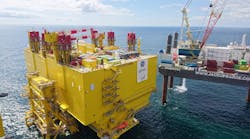With key technological advancements and growing public support, there have been record levels of investment in renewable energy in recent years. Despite the progress, this transition from traditional fossil fuels to renewable energy resources is stymied in some regions of the world by inefficient infrastructure and independent grid systems.
The energy infrastructure of the future will need to look vastly different from what it does today. Rather than having power plants in a central location, we are far more likely to see future development by stringing together multiple wind or solar farms. Such a combination can result in transmission losses along the way as energy travels from the generation point to the consumer.
Thus, bringing significant amounts of renewable energy onto the grid will require a modernized grid system, capable of integrating from clean energy sources and transferring power across long distances, such as from an offshore windfarm. High Voltage Direct Current (HVDC) transmission is key to expediting clean, renewable power for our everyday electricity.
Most power grids use alternating current (AC), which is not efficient over long distances. HVDC systems solve this by transporting electricity in direct current and converting back to AC on delivery. This technology moves up to 3 times more electricity and can reduce losses by up to 30 to 35 percent compared to conventional transmission.
However, HVDC is more than a just way to connect offshore electricity or solar power produced in less densely populated areas to the grid. It represents the ability to efficiently transmit and distribute clean and reliable sources of electricity across great distances, allowing major population centers far from the source to easily make the transition from fuels such as oil, coal and natural gas to renewables such as wind or solar.
With over 75 percent of the world’s energy use happening in cities, there is a significant opportunity for clean energy sources to make up the majority of our everyday electricity needs if we have the right infrastructure in place to reap the benefits of advancements in renewable energy generation. Offshore locations are ideal for wind farms, but without solutions such as HVDC, power can only efficiently reach the coastal cities, making it difficult for urban populations further inland to enjoy the benefits of affordable, clean energy. And in the case of solar, for example in the United States, large solar farms tend to be in less densely populated parts of the country, oftentimes making it more difficult to transmit and distribute that energy across long distances to reach more populated areas. HVDC enables renewable energy to go where it’s needed at any time, with alternate forms of energy (hydro power, fossil fuels) used as back-up.
One example of this is the work GE Power’s Grid Solutions business is conducting on behalf of TenneT Offshore GmbH in in Germany to complete the DolWin3 project, which will rely on GE’s HVDC MaxSine Voltage Source Converters. Together with TenneT, this solution will allow DolWin 3 to transmit and distribute 900MW of electricity produced at the DolWin3 wind farm through 161 miles of subsea and underground cables to a converter station in Dörpen West and an additional 100 miles of subsea and underground cables to an additional converter, where it is converted to alternating current and distributed to the onshore grid. Dolwin3 will bring clean energy to 1 million homes in Germany and helps support “Energiewende,” Germany’s energy transition to a low-carbon, nuclear-free economy.
Solutions such as the one GE is developing in Germany are important pieces of the puzzle when it comes to bringing greater amounts of renewable energy onto the grid as the world demands a faster and higher-impact transition to renewables. In just the next five years, the International Energy Agency forecasts that renewables are expected to account for more than 60 percent of the increase in world electricity generation. Remarkably, just four key markets are expected to lead this growth: China, the United States, the European Union and India, with China leading the group with 37 percent of the growth.
There’s no doubt a silent revolution is happening in the energy and power space. The world has seen strong growth in renewable capacity additions, which have nearly tripled since 2006, according to an analysis of IEA data reviewed by Carbon Brief. For this to continue, however, we must ensure the industry has the systems like HVDC available that enable renewables to be delivered to the grid in a way that ensures long-term efficiency and stability and drives savings to the consumer.


